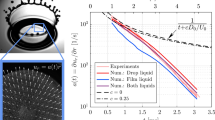Conclusions
-
1.
The surface activity of mineral oils, which can be rated according to the magnirude of dσ/dh, depends on the quantity of substance in the film, its chemical composition, and the properties of the water.
-
2.
The dynamic characteristics Δσ and tp depend on the chemical composition and specific mass of substance of the film, reaching their highest values at thickness hc ≲ 2hp, where hp is the average film thickness at the Pockels point; the dynamic characteristics also depend on the water composition.
-
3.
The relaxation process has several components, and theσ t curves in the region of asymptotic stability are described by the equation\(\sigma _t = \sigma _p + \sum\limits_{i = 1}^N {\Delta \sigma _{0i} e^{ - b_i ^1 } } \). Transition of the surface to a stable state is due to a change of form of the film under the influence of capillary forces and related convective surface diffusion and molecular volume diffusion of surfactants, as well as a change in orientation of the surface-active molecules at the oil-water interface.
-
4.
With thickness h ≫ hp, the film changes over to a different state, and this is accompanied by the formation of structures in the form of oil accumulations without any contact angle (continuous thick films) or with a finite contact angle (lenses). In the latter case, the relaxation process is governed by the establishment of the equilibrium contact angle of the structures that are formed.
-
5.
Correlation of the quantities Δσ, tp, m/S (or h), andɛ shows that at the liquid-gas boundary, reagents are the most effective when used in amounts such that continuous films are created on the bubble surfaces, with film thicknesses twice the minimum thickness that is reached when the oil is completely extended. With increasing m/S, the flotation activity (from the standpoint of the capillary mechanism) of a liquid-gas interface containing an oil film will drop off and approach a state in which Δσ ≤ 0 and there is no strengthening of the contact between the bubble and particles; this has an adverse effect on the degree of extraction and on the particle size in flotation — a relationship that is in qualitative agreement with experimental data and practical experience in flotation.
Similar content being viewed by others
References
V. I. Klassen, S. I. Krokhin, and S. A. Tikhonov, "Effect of covering the bubble-mineral contact area with a nonpolar reagent on the strength of particle adhesion in flotation," Tsvetn. Metall., No. 4 (1962).
V. I. Melik-Gaikazyan, I. N. Plaksin, and V. V. Voronchikhina, "On the mechanism of action of nonpolar sorbents and certain surfactants in froth flotation," Dokl. Akad. Nauk SSSR,173, No. 4 (1967).
N. K. Adam, The Physics and Chemistry of Surfaces, 3rd ed., Oxford University Press, London (1941).
N. S. Belova and S. B. Leonov, "Capillary hydrodynamics of liquid-gas interfacial surface in the flotation process," Fiz.-Tekh. Probl. Razrab. Polezn. Iskop., No. 6 (1993).
M. Reiner, Deformation, Strain, and Flow: An Elementary Introduction to Rheology (2nd ed.), Interscience, New York (1960).
N. S. Belova, I. Ya. Melik-Gaikazyan, V. I. Melik-Galikazyan, et al., "Procedure for instrumental evaluation of flotation activity of various reagents and combinations of reagents," in: Ore Beneficiation [in Russian], S. B. Leonov (ed.), Irkutsk (1986).
J. Van Hunsel, G. Bleys, and P. Joos, "Adsorption kinetics at the oil/water interface," J. Colloid Interface Sci.,114, No. 2 (1986).
A. N. Frumkin, "Phenomena of wetting and adhesion of bubbles," Zh. Fiz. Khim.,12, No. 4 (1938).
Author information
Authors and Affiliations
Additional information
Translated from Fiziko-Tekhnicheskie Problemy Razrabotki Poleznykh Iskopaemykh, No. 6, pp. 87–93, November–December, 1994.
Rights and permissions
About this article
Cite this article
Belova, N.S., Leonov, S.B. Capillary-rheological effects at liquid-gas interfaces containing oil films, and their relation to the flotation process. J Min Sci 30, 595–600 (1994). https://doi.org/10.1007/BF02047329
Received:
Issue Date:
DOI: https://doi.org/10.1007/BF02047329




